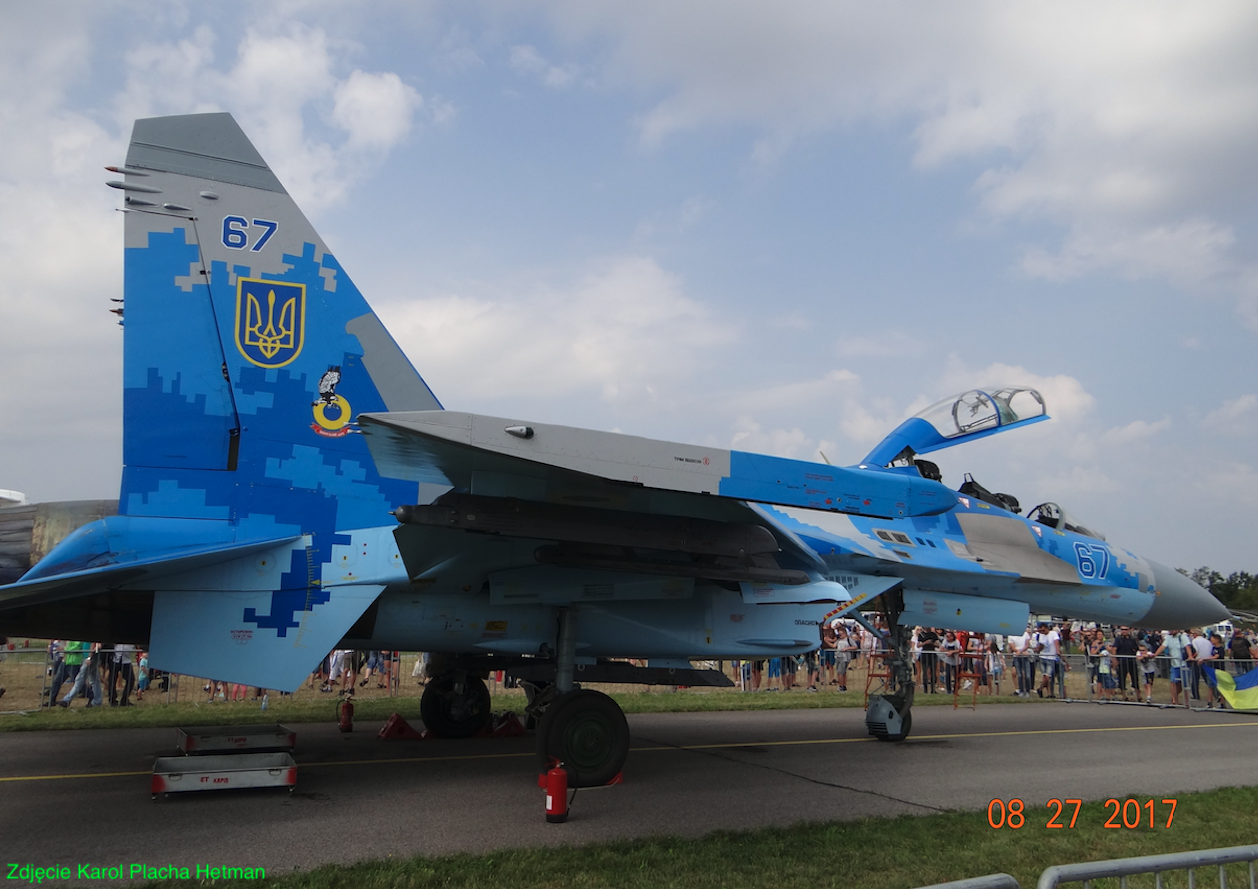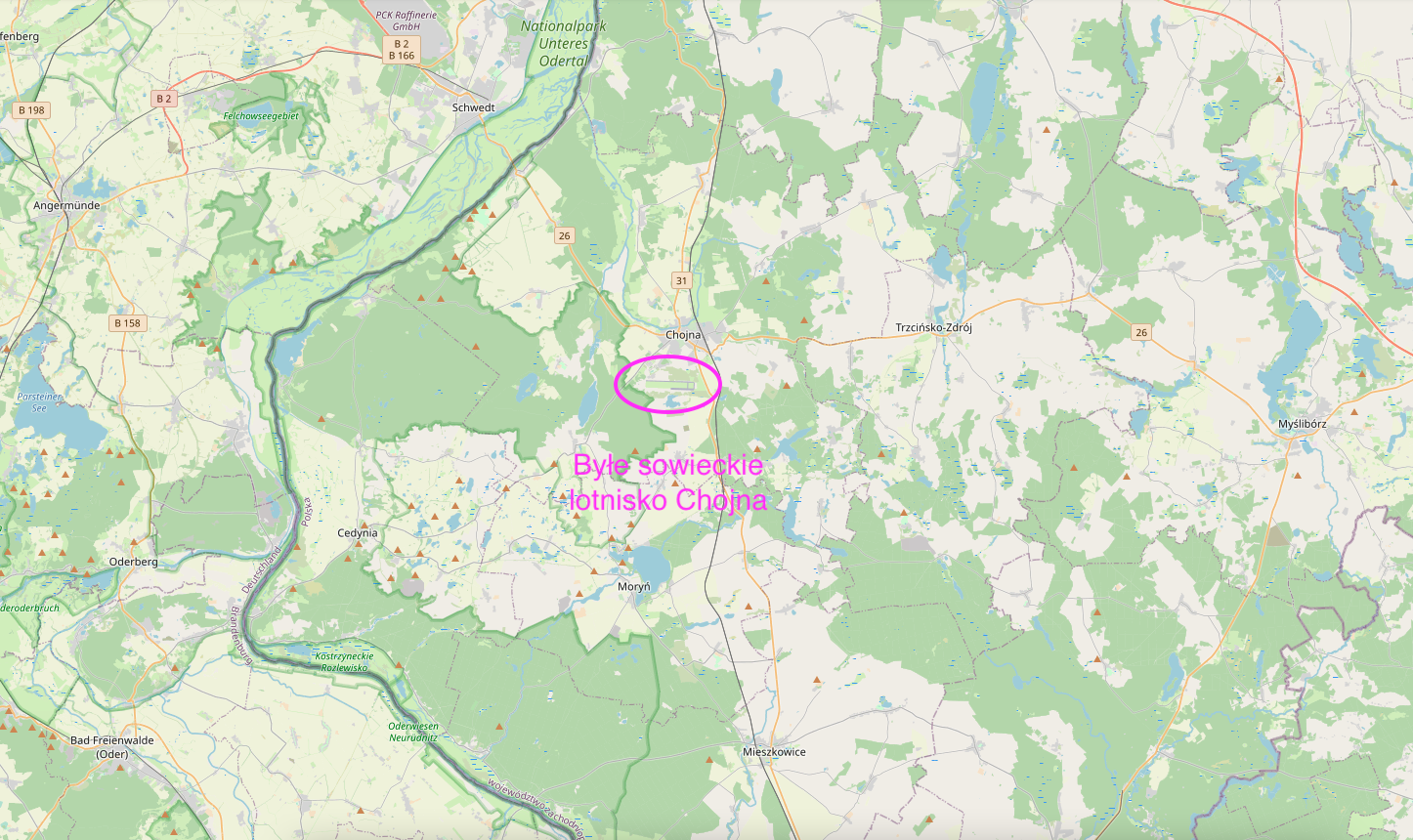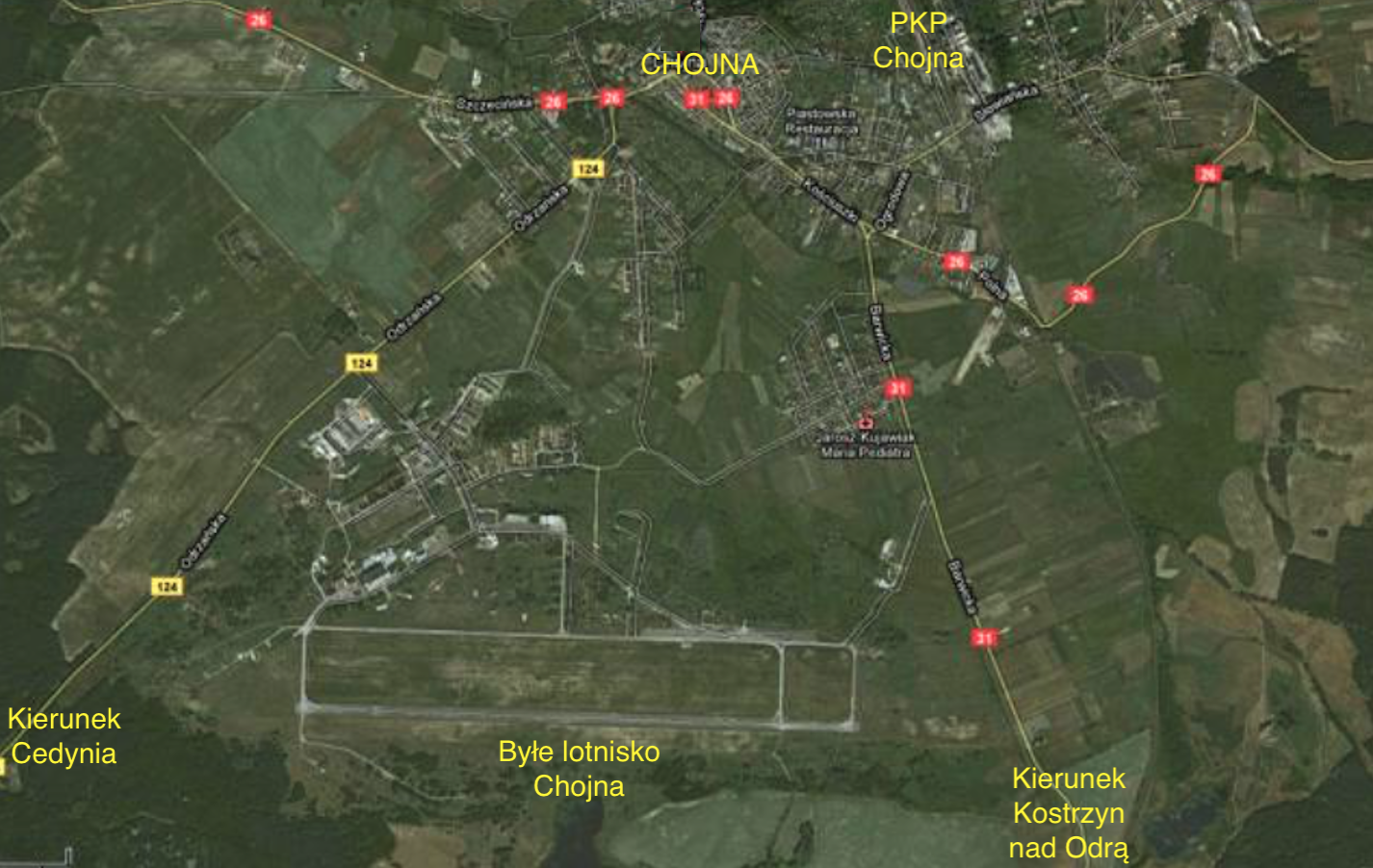Szczecin 2010-01-11
Former Chojna airport.
Geographic coordinates: 52.939N 14.422E. Elevation 57 m above sea level.



The airport in Chojna is history and although it has been within the borders of Poland since 1945, the Polish Army had nothing to do with it. The airport was built just before the outbreak of World War II, when the German army was officially preparing to attack the Republic of Poland.
The airport is located within the city limits of Chojna, on its southern side. Between the Provincial Road No. 124 leading to Cedynia (Odrzańska Street) and the National Road No. 31 to Kostrzyn nad Odrą (Barwicka Street). Roads with paving stones, built in Germanic times, lead to the airport from these routes.
The airport coordinates are; latitude 52 degrees 56 minutes 22 seconds N and longitude 14 degrees 25 minutes 18 seconds E. It is located at an altitude of 57 m above sea level. The airport is currently not listed in any list of airports and in a few years there will be no trace of it. The airport was equipped with RWY, with dimensions of 2,300 m x 50 (48) m with a concrete surface. Oriented on the direction 09/27, which is exactly east-west.
History of the city of Chojna and the surrounding area.
The name Chojna comes from the Pomeranian-Slavic name of Chojnica. The settlement was founded by the Szczecin Piasts in the 10th century. In 1255, like many settlements of Western Pomerania, it received the right of location based on Western law, which was granted by Prince Barnim I. The Brandenburgers took advantage of the district division of the Crown. Initially, through the church, preventing the establishment of a diocese subordinated to the Cathedral in Gniezno, and thus to the Pope, and then incorporating into the structures of the empire. Brandenburg already in 1244, called Chjnice as Konigesberg.
In 1267, the bishops of Brandenburg exempted Chojna from trade and craft taxes, which influenced the development of the city. In 1310, the city received further trade privileges. Most transport takes place along the Rurzyca and Oder rivers. In 1320, the construction of the town hall began, and in the following years the city was surrounded by walls, with three gates (Świecka, Barnkowska and Mostowa, demolished in the 19th century) and several towers - lookouts. The first half of the fifteenth century is the influence of the Teutonic Knights, and then Brandenburg again. In 1410, a new town hall and St. Mary's Church were built, which are now the most valuable monuments of the city after reconstruction. In the 16th and 17th centuries, plagues spread through Chojna, which decimated the population. But the biggest brake on the development of the City are the wars started from the west and north. The effect was such that, apart from the economic stagnation, the historic walls and gates were already being dismantled, and the bricks were used for the construction of barracks and other military buildings. Until the mid-nineteenth century, the only branch of craft was cotton processing and weaving. But it also collapsed with the development of heavy industry. The construction in 1877 of a railway line connecting Szczecin with Kostrzyn revived and developed the city. Chojna became an important trade center of supra-regional importance. This situation lasted until the outbreak of war in 1939.
At the beginning of 1939, the German air force built an airfield at the southern gates of the city. Initially, the airport was used for training purposes. A large barracks center and airport facilities, such as aircraft hangars, were built.
During the fighting in January 1945, the city was of military importance. On February 4, 1945, the population was evacuated and a few hours later Soviet soldiers entered it. But as it turned out, this was not the end of the war in Chojna. On February 16, 1945, the Soviets burned and destroyed almost the entire city. The Church of the Blessed Virgin Mary, the town hall and all tenement houses in the center were destroyed. The urban substance was destroyed in 80%. Soviet terror, rape and theft reigned. The Soviet brothers did not respect their Germanic brothers.
On the basis of supranational agreements, Chojna was granted to Poland. Interestingly, for a few months the city was called Władysławsko, but already at the end of 1945, the former Slavic name of Chojna was adopted. The remaining Germanic population was resettled across the Oder River. In the first years after World War II, the largest population were Muscovites who maintained a large garrison here.
Although many decades have passed since the war, not all war damage has been removed to this day. The Gothic town hall razed to the ground was rebuilt in 1977. A similar fate befell the monastery, which was built practically from scratch. Since 1994, the reconstruction of St. Mary's Church was underway.
In the period 1975–1998, the city belonged administratively to the Szczecin Voivodeship. Currently, Chojna belongs to the West Pomeranian Voivodeship and Gryfino County. It is an urban-rural commune.
Chojna is one of the smaller towns of the Republic of Poland. In 2007, it was inhabited by 7,283 people and this state has been maintained since 2000. There were 1,599 youth and children, 4,822 of working age, and 862 elderly people. Chojna has an area of 12.36 square kilometers. Telephone numbering zone 91. Zip code 74-500. ZGR registration plates.
History of Chojna Airport.
At the beginning of 1939, the German Air Force built an airfield at the southern gates of the city. The airport was used for training purposes. Fighters were stationed at the airfield. Initially, there was a ground take-off field at the airport. The concrete RWY was built during the war.
During the Second World War, at the airport, at the disposal of the garrison commander, there was an extensive car park, communication network, service companies and guard companies, garrison fire brigade, etc. In addition, the air base in Chojna had spare airports in: Moryń (Mohrin), Mieszkowice (Bärwalde), Jaworze (Gabbert), Chełm Dolny (Wartenberg). During the war, the Germans also used women from the branch of the concentration camp in Ravensbrück to expand the airport in Chojna and reserve airports.
The military importance of the airport grew as the Soviet front approached. From January 14, 1945, when the January offensive began, planes and pilots in Chojna were in full readiness. Aircraft with turbojet propulsion appeared on the armament. Chojna found itself in the lane of action of the 1st Belorussian Front of Marshal Georgy Zhukov. At the same time, the airport staff, on the order of the mayor of Chojna, organized a field kitchen for the refugees who passed through Chojna on their way west. When the Soviet tanks, at the end of January 1945, began to approach Chojna, the commander of the airport began preparations to evacuate the garrison and blow up the infrastructure of the airport and the planes gathered there, which could not be evacuated. The forces gathered at the airport, numbering about 1,500 people, were evacuated across the Oder River over the bridge in Schwedt. The airworthy planes that had to be piloted flew to Hallen airport. The buildings and infrastructure of the airport were blown up on the night of January 31, 1945/February 1, 1945. The fires raged for two more days. However, despite this, a few airworthy aircraft and ammunition supplies remained at the airfield.
On February 4, 1945, the Soviet army occupied the Chojna Airport and did not leave it until 1994, i.e. nearly 50 years. Despite the damage done to the airport by the retreating Germans, the Soviet army had a number of facilities at its disposal. Barracks of the half-timbered construction still stood. There were two repair hangars. One with a capacity of 46,200 cubic meters and a smaller one with a capacity of 30,000 cubic meters. The walls of the air traffic control tower and others were standing.
Initially, various air units were stationed at the airport, transferred from east to west and vice versa. In 1950, the airport was taken over by the 582nd Fighter Aviation Regiment from the CCCP. The regiment was stationed in Chojna until 1994. Recently, the Soviet regiment used Sukhoi Su-27 aircraft.
In 1951, the Soviets expanded the airport in Chojna. This involved the liquidation of nearby farms, which were not occupied by farmers anyway. A new concrete RWY was built, which was oriented east-west. It had dimensions of 1,800 m x 40 m. It was also planned to build another RWY, parallel to the existing one, but in the end only one RWY was built, with a ground-grass surface.
Under the relevant agreements in 1956, i.e. after the creation of the Warsaw Pact, the area of the Chojna Airport was excluded from Polish jurisdiction, although it was only a formality. The airport was heavily guarded from the moment it was taken over by the Soviets. There were numerous guard posts, foot and motorized patrols. Every civilian vehicle that was going in the direction of Cedynia or Kostrzyn was inspected and its driver slowed down a bit, not to mention those who stopped carelessly. Because the airport was in contact with the city, the surveillance of the Soviet services was very high. In the city itself, it was not possible to build tall blocks, because they could be used to observe the military base.
The Soviets systematically expanded the base, erecting on it a number of facilities necessary for its efficient functioning, while implementing more and more modern types of armament. The area of the garrison increased to 495 hectares.
Since the Soviet regiment belonged to the first-line (first-line) in the structures of the Warsaw Pact, it always had the latest fighter aircraft in stock. Initially MiG-15, MiG-17, then MiG-21, MiG-23, MiG-25 (?), and ended with Su-27. Before leaving Poland, the regiment had 30-34 Su-27 machines in stock.
At the beginning of the 1970s, shelter-hangars were built for the MiG-21 aircraft. From Russian called lupins. In Poland, the Soviets built shelters - hangars model AU-11 (Angar Ubnia) for MiG-21 aircraft and model AU-16 for Su-27 aircraft. AU-16 type hangars have flue gas sluices in the rear wall. Thanks to this, it was possible to start the aircraft's engines in the hangar. Garages were erected for the growing car park. Ammunition warehouses and bomb depots with an area of approximately 9.4 ha were located on the airport premises. With high probability, we can write that nuclear weapons were also kept in them. There were more than 260 different buildings and structures on the site. The fuel depot had a capacity of 21,700 cubic meters.
At that time, a modern aircraft control and guidance station was also installed, including a long-range navigation system. 31.5 hectares have been allocated for these facilities. In the period from 1965 to 1970, the airport had the call code ANGARKA, and in the period from 1970 to 1990 ANTRAKT.
In the 70-80s, the air defense system was constantly developed. The 89th Anti-aircraft Missile Regiment was installed in the garrison, with Volkhov-type surface-to-air missiles. Also on the base was located a regiment (brigade) of missile forces with surface-to-surface missiles. This information is certain, considering the buildings that were built at the airport. We mean reinforced concrete hiding places in the shape of a pipe covered with earth, called Granit. This type of hiding can be found in almost all post-Soviet bases (Bagicz Airport) and not only air bases (e.g. Świnoujście Mulnik), operated in Poland. Self-propelled ballistic missile launchers of the R-11 class, with a range of 300 km, and then the RSD-10 Pionier were hidden here.
The 380th independent Battalion of Airport Technical Security was also stationed in the Chojna garrison. There was also a so-called pilot school in the base, where young pilots newly arrived to the regiment supplemented their piloting knowledge and tactics in a potential conflict zone.
We also need to know that the Soviet garrisons in Poland were self-sufficient. There were shops-canteens, a hospital, a bakery, canteens and sports and recreation facilities. The garrison hospital had a cubic capacity of 2,986 cubic meters. Outside the borders of the base in the village of Stoki on Lake Ostrów, the Soviets had a recreation and recreation center at their disposal. We estimate that there were from 2,000 to 4,000 people in the base at various times.
Much of the supplies were brought in by air. But by far the most goods were delivered by road transport - trucks. The Soviets rarely used the echelon railroad, due to the modest network of wide tracks in Poland. In the government-military agreements between Poland and the CCCP, eight routes were set in Poland, which Soviet road transports could move without any notification to the Polish administration. The columns were dominated by cars; Zil, Kraz, Maz and Belaz, and in the 80s Kamaz. Of the smaller vehicles were; Gas, later Uaz.
Among the inhabitants of Chojno and the surrounding area, information is circulating about kilometers of underground tunnels running even to the Cathedral in Chojno, which were created during the war. According to the available information, this is true, only exaggerated. Designs of German airports included many innovative solutions, which did not always work in the following years. One of such projects is a system of delivering fuel to planes not by road tankers, but by a system of pipelines running through underground tunnels directly to the aircraft stand. The same applies to the RWY heating system, the central heating system, which theoretically makes it usable even in heavy snowfall and low temperatures.
Soviets go home.
On May 5, 1992, the 582nd PLM officially flew to Smolensk, and on July 7, 1992, the airport was handed over to the authorities of the Republic of Poland, although the last Soviet soldier left Chojna in 1994. Leaving the facility, the Soviets devastated it very much, which should not surprise anyone. This is a basic law of primitive warlike peoples - if they can't take something with them, they destroy it.
After the Muscovites left the airport, the property was taken over by the Chojna Commune. Internal roads became streets and were given names. Most of these names are strongly associated with Poland and Polish Aviation; Żwirki i Wigury, General Anders, General Władysław Sikorski, Orląt and others. Slowly but systematically, the ruined area acquires new typical urban functions; residential, commercial and manufacturing. A large part of the facilities has already been adapted by various companies. The rest is waiting for investors. The hangars are in good condition. One of them even houses a boxing club. At one time there were big discos and performances of music bands, organized by the owner of the club Champion. So far, Chojna Airport is a paradise for paragliders, motor hang gliders, balloons, and model aircraft. There are many paragliders taking off from winches. However, no Aeroclub or Aviation Association was established in Chojna. Despite this, several cultural events were organized at the former airport. Their organizers were; Chojna Town Hall, Chojna Cultural Center and Student Sports Club "Stoki". Firefighting dromedaries and rescue helicopters are still landing here. In one of the hangars, the Champion Club was organized, where games for young people were organized.
In the following years, a large part of the former airport is already adapted by various companies. The rest is waiting for investors. The hangars are in good condition. One of them even houses a boxing club. There are still many paragliders.
Written by Karol Placha Hetman
